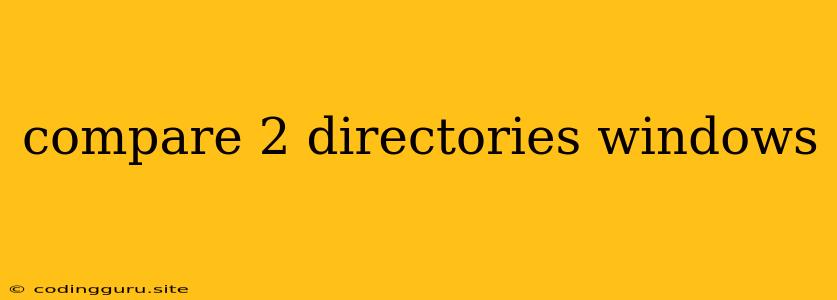Comparing Directories in Windows: A Guide to Finding Differences
Comparing directories is a fundamental task in various situations, from managing files to identifying changes in project folders. Windows offers a few methods to compare directories, each suited to different needs. This guide provides a comprehensive overview of the most popular techniques for comparing directories in Windows, along with their advantages and limitations.
1. Using the File Explorer
The most straightforward method is using the built-in Windows File Explorer. While this method doesn't provide a detailed comparison report, it's an excellent starting point for quickly identifying major differences.
Steps:
- Open the File Explorer and navigate to the first directory.
- Open the second directory in a separate File Explorer window.
- Maximize both windows for easier comparison.
- Visually compare the contents of both directories. You'll see if files or folders are missing, duplicated, or renamed.
Advantages:
- Simple and intuitive: This approach requires no additional software.
- Fast and efficient: For quick visual comparison, this is the most convenient method.
Limitations:
- Limited detail: It doesn't show subtle file differences like size, date modified, or content.
- Manual comparison: You'll need to scroll and visually scan through both directories, which can be tedious for large folders.
2. Employing the Command Prompt
For a more detailed and automated approach, the Windows Command Prompt (cmd) offers a powerful tool called "fc". This command can compare the contents of two files or two directories, providing a detailed report of their differences.
Steps:
-
Open the Command Prompt by searching "cmd" in the Start menu.
-
Navigate to the directory containing the folders you want to compare.
-
Use the "fc" command with the following syntax:
fc /b [folder1] [folder2] > [output_file.txt]- Replace [folder1] and [folder2] with the paths to the two directories.
- [output_file.txt] is the name of the file where the comparison results will be stored.
Advantages:
- Detailed comparison: Provides a comprehensive report of file differences, including size, date modified, and content changes.
- Automated comparison: Eliminates manual scanning and streamlines the comparison process.
Limitations:
- Requires command line knowledge: Understanding command syntax is necessary.
- Limited UI: Output is displayed in text format, requiring manual analysis.
3. Utilizing Third-Party Tools
For advanced features and user-friendly interfaces, consider using dedicated third-party software designed for comparing directories. These tools often offer features such as:
- Graphical comparison: Visual representation of differences with highlighted changes.
- File content comparison: Detailed analysis of differences within files.
- Filtering and sorting: Ability to focus on specific file types or changes.
- Reporting options: Generating comprehensive reports in various formats.
Popular options include:
- WinMerge: Free and open-source tool with a user-friendly interface.
- Beyond Compare: Powerful tool with advanced features and a paid subscription.
- Total Commander: File manager with a built-in directory comparison feature.
4. Exploring Other Options
While the above methods are the most commonly used, other approaches for comparing directories in Windows exist. Some examples include:
- Version Control Systems (VCS): Git, Mercurial, and SVN are examples of VCS tools that track changes in files and directories, facilitating comparison and merging operations.
- Cloud Storage Services: Services like Dropbox, Google Drive, and OneDrive offer built-in file comparison features, allowing you to see differences between versions of files.
Choosing the Right Method
The best method for comparing directories in Windows depends on your specific needs:
- Quick visual inspection: Use the File Explorer for a straightforward overview.
- Detailed file comparisons: Employ the Command Prompt with the "fc" command or utilize third-party tools.
- Advanced version control and collaboration: Consider using Version Control Systems for comprehensive change tracking and merging capabilities.
Conclusion
Comparing directories in Windows offers various approaches, each with its unique strengths and limitations. From the simple File Explorer to the powerful command line tools and third-party software, you can choose the best method that fits your specific needs and desired level of detail. By understanding the available options, you can efficiently identify changes in directories, manage files effectively, and streamline your workflow.
